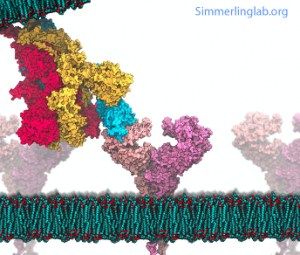Date: 09/22/2020
Time: 1:00 pm - 2:00 pm
Location
Zoom
Description
Using computer simulations to model the SARS-CoV-2 spike glycoprotein and block COVID-19 infection
Carlos Simmerling
Department of Chemistry, and Laufer Center for Physical and Quantitative Biology
Stony Brook University
www.simmerlinglab.org

Our computer model of initial contact of ACE2 receptor on human cell (pink) and the viral spike (red/yellow/blue).
Coronaviruses (CoVs) are so named due to the similarity of their appearance to a crown, with small protrusions of “spike” proteins covering their surface. The virus uses these spikes as molecular keys to unlock entry into and infect a host cell. Spike proteins are the key target of neutralizing antibodies, but development of immunity is slow. Furthermore, antibodies tend to interact with the spike in the highly variable exposed regions, thus development of immunity to one CoV strain does not provide protection against another. We hypothesized that small molecule drugs could interact with the spike prior to immunity development, and block the conformational changes that are crucial to membrane fusion and infection. Modern drug discovery methods use structure to guide drug design, however these are hampered for COVID-19 because experimental structures are missing key regions for all coronavirus spikes, and none of the hypothesized membrane fusion steps have been directly observed. We are bridging this gap with computer models that can: complete the partial structures obtained from experiments, map the process of membrane fusion, and identify opportunities where drugs could block viral entry. Such drugs have the potential to be broadly neutralizing of all CoVs, leading to effective treatments for COVID-19, SARS, MERS as well as future pandemics caused by as-yet unknown CoVs.
About the Speaker
Dr. Carlos Simmerling obtained his Bachelor’s degree (1991) and PhD (1994) in Chemistry at the University of Illinois at Chicago, performing early research on methods for computer modeling of biomolecules such as proteins. He then went on to a post-doctoral fellowship in Pharmaceutical Chemistry at UCSF, where he became a lead developer of the Amber biomolecular simulation software that is used in thousands of research labs worldwide. In 1998 Carlos joined the Chemistry department at Stony Brook University, where he is currently a Professor, and he became the Associate Director of SBU’s Laufer Center for Physical & Quantitative Biology. His NIH- and NSF-funded research focuses on development of improved simulation methods and models, and using these tools to study biomolecular recognition mechanisms. His articles on improving the physics used in biomolecular modeling have been cited nearly 10,000 times. Dr. Simmerling is currently the Marsha Laufer Chair of Physical & Quantitative Biology at Stony Brook University and a Fellow of the American Chemical Society.
Registration
Please register for the event via Zoom.
After registering, you will receive a confirmation email containing information about joining the meeting.
Clara Tran
Email: clara.tran@stonybrook.edu
Latest posts by Clara Tran (see all)
- 2025 Spring Semester: Reference and Virtual Chat Services - January 26, 2025
- Nikita Soni, PhD student,on “Human-Centered Large Language Modeling” - November 26, 2024
- Dr. Jesus Rios on “Can a machine learn chemistry?” - November 8, 2024

